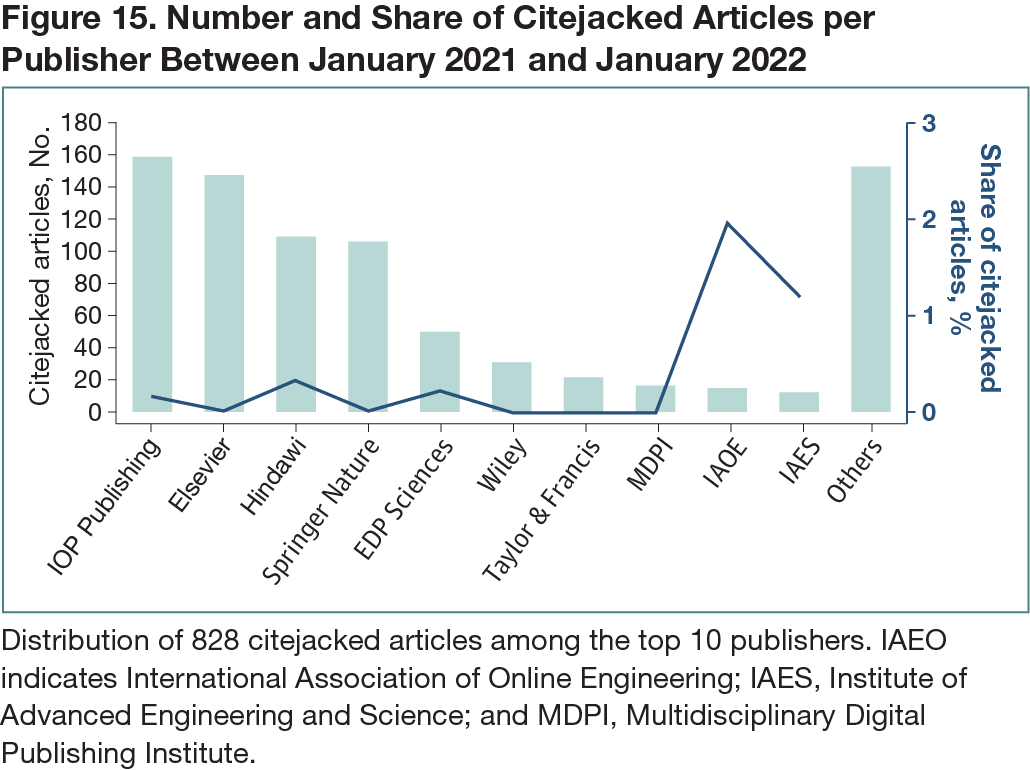Abstract
Improper Legitimization of Hijacked Journals Through Citations
Anna Abalkina,1 Guillaume Cabanac,2 Cyril Labbé,3 Alexander Magazinov4
Objective
Hijacked journals are fake websites that use the titles, International Standard Serial Numbers (ISSNs), and metadata of established journals to appear legitimate so they can collect publishing fees from unsuspecting authors without peer review. There are more than 200 documented cases of hijacked journals,1 most of which publish low-quality or dishonest research. Moussa documented citations in legitimate journals to hijacked journal articles in the field of marketing.2 This study sought to document the number of citations in legitimate journals to articles in hijacked journals, thus potentially legitimizing those unreliable articles and fraudulent journals.
Design
In this cross-sectional study, a citejacked detector, designed as a part of the Problematic Paper Screener,3 articles in legitimate journals citing hijacked journal articles (ie, citejacked articles) were tabulated. The detector screened 12 journals documented to be hijacked, with the hijacked versions erroneously indexed in international bibliographic databases. A full-text search was performed between November 2021 and January 2022 with Dimensions, a bibliometric database containing more than 100 million publications, using the name of 1 of the 12 hijacked journals and including articles published and indexed between January 1, 2021, and January 31, 2022. To exclude items published in preprints or predatory journals, the search was limited to the articles published in journals listed in the Norwegian Register for Scientific Journals, Series and Publishers. Each retrieved item was manually checked to retain true positives (citations to hijacked journals) and discard false positives (citations to authentic journals or other mentions of journals).
Results
Of 1421 articles featuring the title of a hijacked journal, 828 (58.3%) cited unreliable articles from hijacked journals. Citejacked articles were published by 67 publishers. Figure 15 shows the distribution of citejacked articles among the top 10 publishers. Flagship publishers were not immune to incorporating references to hijacked journals in their citation index. Between January 1, 2021, and January 31, 2022, a mean of 2 citejacked articles were published daily in established journals.
Conclusions
Reputable journals cite unreliable articles from hijacked journals, legitimizing such pseudo-articles. The presence of citejacked articles in reference lists points to a flaw in the peer review process and shows that curation of references must be taken more seriously. These flawed references to illegitimate journals may serve as markers of articles that are problematic due to plagiarism in articles originating from hijacked journals, citation cartels, and paper mills. Given the limited number of titles included in this study (12 among the more than 200 documented2), the phenomenon might be wider and has not yet been systematically studied.
References
1. Abalkina A. Detecting a network of hijacked journals by its archive. Scientometrics. 2021;126:7123-7148. doi:10.1007/s11192-021-04056-0
2. Moussa S. A “Trojan horse” in the reference lists: citations to a hijacked journal in SSCI-indexed marketing journals. J Acad Librarianship. 2021;47(5). doi:10.1016/j.acalib.2021.102388
3. Problematic Paper Screener. February 27, 2021. https://www.irit.fr/~Guillaume.Cabanac/problematic-paper-screener
1Freie Universität Berlin, Berlin, Germany, anna.abalkina@fu-berlin.de; 2Computer Science Department, University of Toulouse, Institut de Recherche en Informatique de Toulouse, Toulouse, France; 3Université Grenoble Alpes, National Centre for Scientific Research, Grenoble, France; 4Yandex, Moscow, Russia
Conflict of Interest Disclosures
None reported.
Funding/Support
Cyril Labbé and Guillaume Cabanac were supported by ERC-Synergy NanoBubbles (ERC-2020-SyG-951393)

